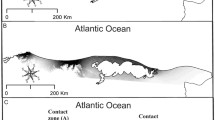Summary
Seed distribution (clump size) selection has been proposed as a possible mechanism of resource subdivision for competing heteromyid rodent species. To test this hypothesis, field experiments were conducted over two years during both richer and sparser seasons of the year. None of the predictions derived from the hypothesis were supported by our results. Though some selectivity was displayed by both Dipodomys spectabilis and D. merriami, the patterns of selectivity did not match the expected patterns. Our results further indicate that clump selection may be influenced by variables other than the density of seeds within a clump. These results have led us to conclude that clump size selection is unlikely to play a role in the coexistence of different species of the genus Dipodomys.
Similar content being viewed by others
References
Bowers M (1979) Coexistence in desert rodents: a multivariate analysis. Unpublished M.S. thesis, Brigham Young University
Brown JH (1973) Species diversity of seed eating rodents in sand dune habitats. Ecology 54:775–787
Brown JH (1975) Geographical ecology of desert rodents. In: ML Cody, JM Diamond (eds), Ecology and Evolution of Communities. The Belknp Press of Harvard University Press, Cambridge, Massachusetts
Brown JH, Lieberman GA (1973) Resource utilization and coexistence of seed-eating desert rodents in sand dune habitats. Ecology 54:788–797
Dawson TJ (1976) Energetic cost of locomotion in Australian hopping mice. Nature 259:305–307
Dawson TJ, Taylor CR (1973) Energetic cost of locomotion in kangaroos. Nature 246:313–314
Frye RJ (1981) Coexistence of a large and small species of Dipodomys: exploitative vs interference competition. Unpublished Ph D dissertation, University of Arizona
Hoagstrom CW (1978) Ecological distribution of nocturnal rodents in a part of the Sonoran desert. Unpublished Ph D dissertation, University of Arizona
Hutto RL (1978) A mechanism for resource allocation among sympatric heteromyid rodent species. Oecologia (Berl) 33:115–126
Lemen CA (1978) Seed size selection in heteromyids. Oecologia (Berl) 36:1201–1219
Lemen CA, Rosenzweig ML (1978) Microhabitat selection in two species of heteromyid rodents. Oecologia (Berl) 33:127–135
Mares MA, Williams DF (1977) Experimental support for food particle size resource allocation in heteromyid rodents. Ecology 58:1186–1190
M'Closkey RT (1978) Niche separation and assembly in four species of Sonoran Desert rodents. Amer Natur 112:683–694
Monson G (1943) Food habits of the banner-tailed kangaroo rat in Arizona. J Wildl Mgmt 7:98–102
Monson G, Kessler W (1940) Life history notes on the Banner-tailed kangaroo rat, Merriam's kangaroo rat, and the white-throated wood rat in Arizona and New Mexico. J Wildl Mgmt 4:37–43
Price MV (1978) The role of microhabitat in structuring desert rodent communities. Ph D dissertation, University of Arizona 1976
Price MV (1978) Seed dispersion preferences of coexisting desert rodent species. J Mammal 59:624–626
Price MV (1979) The role of microhabitat in structuring desert rodent communities. Ecology 59:910–921
Reichman OJ, Brown JH (1979) The use of torpor by Perognathus amplus in relation to resource distribution. J Mammal 60:550–555
Reichman OJ, Oberstein D (1977) Selection of seed distribution type by Dipodomys merriami and Perognathus amplus. Ecology 58:636–643
Rosenzweig ML (1973) Habitat selection experiments with a pari of coexisting heteromyid species. Ecology 54:11–117
Rosenzweig ML, Sterner PW (1970) Population ecology of desert rodent communities: body size and seed-husking as bases for heteromyid coexistence. Ecology 51:217–224
Rosenzweig ML, Winakur J (1969) Population ecology of desert rodent communities: habitats and environmental complexity. Ecology 50:558–572
Schroder GD, Rosenzweig ML (1975) Perturbation analysis of competition and overlap in habitat utilization between Dipodomys ordii and Dipodomys merriami. Oecologia (Berl) 19:9–28
Smigel BW, Rosenzweig ML (1974) Seed selection in Dipodomys merriami and Perognathus penicillatus. Ecology 55:329–339
Smigel BW, Jester W, Blomgren J, Prasad K, Rosenzweig ML (1974) Dietary analysis in granivores through use of neutron activation. Ecology 55:340–349
Stamp NE, Ohmart RD (1978) Resource utilization by desert rodents in the Lower Sonoran Desert. Ecology 59:700–707
Whitford WG, Dick-Peddie S, Walters D, Ludwig J (1978) Effects of shrub defoliation on grass cover and rodent species in a Chihuahuan desert ecosystem. J Arid Environments 1:237–242
Wondolleck JT (1975) The influence of interspecific interactions on the forage areas of heteromyid rodents. Unpublished master's thesis, University of Arizona
Author information
Authors and Affiliations
Rights and permissions
About this article
Cite this article
Frye, R.J., Rosenzweig, M.L. Clump size selection: A field test with two species of Dipodomys . Oecologia 47, 323–327 (1980). https://doi.org/10.1007/BF00398524
Received:
Issue Date:
DOI: https://doi.org/10.1007/BF00398524




